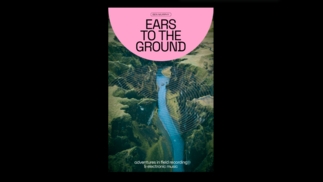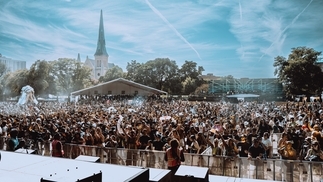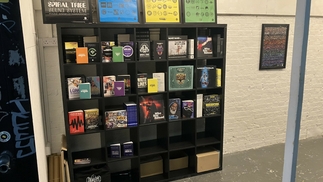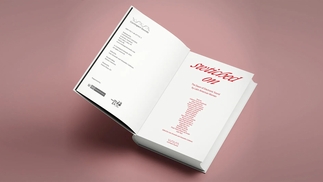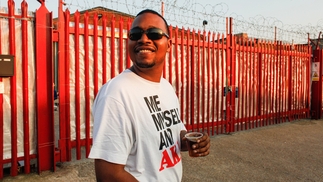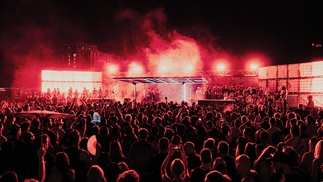DANCE BOOKS: THE STORIES & THE SONGS
We pick out 10 of the best books inspired by the early days of acid house

“Those were good days in Edinburgh, in 1990,” says author and screenwriter Trevor Miller, who wrote the acid house culture’s first novel, published in 1989 by Avernus Creative Media. “It was me, DJ Harvey, Sean McClusky, Choci, Graeme Park and hundreds of tabs of acid.”
During that summer of 1990, Trevor staged a “one-man-show” live version of his novel Trip City — a story of drugs, electronic music, raves, clubs and murder — which ran for three weeks at the Playhouse Theatre.
Stephen Fry saw that show, says Trevor, and also in the audience was “a young writer called Irvine Welsh”.
“He was a strange looking character back then,” says Trevor. “And I remember he ended up coming to the show quite a few times.”

This was long before Irvine penned his first stories inspired by acid house and dance music culture. Back then, in 1990, the subcultural movement was relatively new. People were too busy living it to put pen to paper and write about it. Until Trevor came up with the idea of Trip City, that is. And decided to put it out with a cassette full of tunes penned especially for the project by A Guy Called Gerald (he had just had a hit with ‘Voodoo Ray’ that year).
This autumn Trevor is re-releasing Trip City (through 1234 Records) with some “story tweaks” and new music — Paul Oakenfold and Steve Aoki have both created new tracks for the project. And it’s nearly 25 years since Trevor put out the first version. “In 1987, I was living in London and I knew the promoters who’d put on one of the capital’s first warehouse parties, called the Original Warehouse,” says Trevor, who now lives in LA. “Also involved with this party were Dave Mahoney and Phil Dirtbox, and they went on to promote a party called Dirtbox.”
You can pre-order the new version of Trip City via PledgeMusic here. Check out the website here.
It was around that time that the acid house scene started to take grip in London. And Trevor found himself in the middle of it.
“Everyone scored speed and weed from the same people,” he says. “We all went to the same pubs, the same clubs — it was almost like a secret society.”
Then, in the summer of 1988, everything changed. “They said the pills came from San Fran — but we all knew this stuff was being cranked out in Amsterdam or even closer,” says Trevor. “Everyone wanted an E, wanted to sell you an E, give you an E, or buy you an E. Acid was passé, even though the new music was called acid house.”
In the haze of all this new music, exciting nightlife and drug culture, what could Trevor do but write a novel?
“I wrote about what I knew,” he says. “Club people, designer drugs, murder and mayhem.”

He might have been the first to write about acid house but Trevor wasn’t the last. Since Trip City first came out, there have been loads of books — both fiction and non-fiction — written about the subcultural movement that spawned the global dance music scene. This month, we’ve trawled through all these books and picked out 10 of the best...
1
Disco Biscuits
Edited by Sarah Champion
(Sceptre, 1997)
This “chemical fiction” collection was released to mark the 10th anniversary of the birth of acid house. Compiled by Manchester-born music journo Sarah Champion it includes entries from Irvine Welsh, Nicholas Blincoe and The Beach author Alex Garland. Gavin Hill’s story, White Burger Danny, is a quirky tale of bad-turned-good, about a football thug who mellows after necking an E and having his acid house epiphany. Another fine tale is Jeff Noon’s DJNA, a sci-fi story that explores the more ‘acid’ side of acid house.
2
The Acid House
By Irvine Welsh
(W. W. Norton & Company, 1994)
When it first emerged, rave was an anarchic, underground, undefined movement. This compendium is a series of very short stories with outrageous, seedy characters playing out ridiculous scenes in vastly different scenarios; all themed around early acid house culture. A story about an acid casualty who turns into a newborn baby is as Kafka-esque as the footballer who becomes a fly. There are 22 stories in all; each one so potently shocking that the book was turned into a film of the same name in 1998.
4
Energy Flash: A Journey Through Rave Music and Dance Culture
By Simon Reynolds
(Picador, 1998)
When music journalist Simon Reynolds set about writing Energy Flash, in the late 1990s, he said he felt as if the rave scene “had stopped for breath”. And this book is his attempt at taking stock of what had happened from the beginnings of acid house to that point — a time when big beat was, well, big; and “speed garage was a delicious twist in the London pirate radio story”. Full of musings and interviews from some of the best — including Aphex Twin, Goldie and illegal rave posse Spiral Tribe — this captures that moment in time and what came before it, perfectly. There was an updated version too — released last year.

5
Last Night A DJ Saved My Life
By Bill Brewster and Frank Broughton
(Grove Press, 1999)
This informative, detailed and utterly absorbing thesis on the role of the DJ in modern culture remains THE DJ’s bible. Tracing DJ culture, as we know it back to the early 1900s, authors Bill and Frank, both DJs themselves, explain exactly why the DJ holds the hallowed ‘rock star’ status previously occupied by people who play and make guitar music. Filled with rare interviews and unique insights from DJing greats the original version of this book came with a compilation album too, released on Nuphonic Records the same year.

6
Adventures in Wonderland: A Decade of Club Culture
By Sheryl Garrett
(Headline Book Publishing, 1999)
The music that drove the UK’s late-1980s acid house movement was directly linked to the underground, black, gay disco and house scene from Chicago and this book is one of the best non-fiction tomes to tell that story, mainly because it is written by one of the greatest youth culture scribes of that era. Sheryl Garrett was editor of The Face when acid house exploded and, as it blasted out of the underground into mainstream consciousness, she commissioned and wrote articles about the music, fashion, drugs and cultural issues surrounding it all. That’s exactly what this book does.

7
Altered State: The Story of Ecstasy Culture and Acid House
By Matthew Collin
(Serpent’s Tail, 1997)
This book traces the history of ‘ecstasy’ back to Germany in 1912 when, according to the author, the first little E pill was synthesised, through to the first shoots of the culture that would embrace it. Matthew links the music and culture that drove America’s gay disco scene of the 1970s to late-1980s Britain, crippled by recession and Thatcherism, says Matthew, that took relief in rave culture and the freedom of expression and hedonism it offered. Later versions of this book came too.

8
45
By Bill Drummond
(Abacus, 2001)
This semi-autobiographical collection of short stories and essays written when the ‘King Boy D’ half of the KLF was 45-years-old is every bit as kooky, engaging and unpredictable as his career; highlights of which included setting alight to a one-million-pound pile of cash on a remote Scottish island and burning it to dust, and collaborating with country star Tammy Wynette for a KLF release. Taking a snapshot of his life at the justified and ancient age of 45, these stories mosey from the mundane moments committed to paper to fractured tales of a tortured soul coping with a mid-life-crisis. Either way, it’s art as life as art and the work of a true maverick.
9
Boy’s Own Book: The Complete Fanzines 1986-1992
Compiled by Frank Broughton and Bill Brewster
(DJhistory.com, 2009)
The Boy’s Own fanzines first emerged in 1986 when Andrew Weatherall, Terry Farley, Steve Mayes and Cymon Eckles got together to publish a fan magazine featuring all the stuff they were interested in — namely fashion, drugs, football and, of course, music. Many of the original copies of these rudimentary mags are collector's items but you can get them all here, in an edition that gives you an insight into what some of the most prolific originators of early acid house culture (they went on to start a record label called Junior Boy's Own) were into back in the day. Girls will find it interesting too!

10
The Hacienda: How Not To Run A Club
By Peter Hook
(Pocket Books, 2014)
As co-founder of New Order and Joy Division (he was the bassist), Peter Hook isn’t short of a few anecdotes. And this, the story of the highs and lows of his job as co-owner of the Hacienda pretty much reads as the story of the acid house scene as it took hold in the north of England in the late 1980s. ‘Sad’, ‘funny’, ‘scary’ and ‘strange’ are all words that have been used to describe this book. It’s actually the riveting memoir of a man who was in the right place, at the right time, for some of the best nights out in history. A limited-edition batch of 400 copies of this came with “a rare 10” vinyl” and an alleged piece of the Hacienda’s dancefloor.
